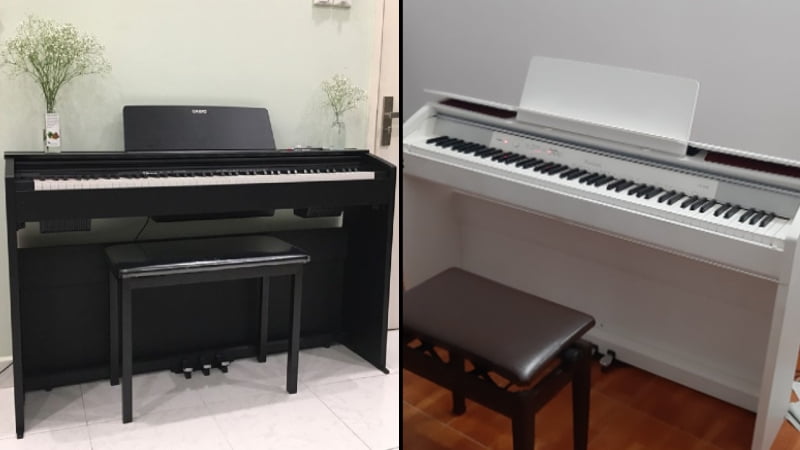Learn why the PX-870 is a better pick over the PX-850 in this Casio PX-870 vs PX-850 review.
In most piano circles, the Casio PX-870 is considered an upgrade of the Casio PX-850. But when I looked at the specs, I couldn’t find much of a difference. So, what’s so special about the Casio PX-870 is that it’s more expensive and popular than the PX-850.
Well, there are actually quite a few reasons. When I dove deep into these two pianos, I saw all the upgrades available on the PX-870 and exactly why it’s the better option between the two.
The Casio PX-870 offers fuller and more detailed tones while also giving you more options when it comes to your sound. So, if you’re looking for a premium and more versatile piano between these two options, the Casio PX-870 is the easy winner.
That said, there are still some people that might prefer the Casio PX-850. And in this Casio PX-870 vs PX-850 comparison, I’ll show all the features and benefits that either piano has to offer. So, by the end of this comparison, you’ll know exactly which piano is the best fit for your home.
Read on to learn more.
Casio PX-870 vs PX-850: A Head-to-Head Comparison




Last update on 2025-12-13 / Affiliate links / Images from Amazon Product Advertising API
Casio PX-870 vs PX-850: A Head-to-Head Comparison
There are three major comparison points I always consider when comparing digital pianos. These are the tone, feel, and polyphony of the piano, as I believe these to be the most important characteristics of any digital piano.
And based on these comparison points, the Casio PX-870 comes out on top with a score of 3-2. These pianos were tied in almost all categories. But since the Casio PX-870 offers a better tone and more sound options, it ultimately came out on top.
Tone
The winner: Casio PX-870
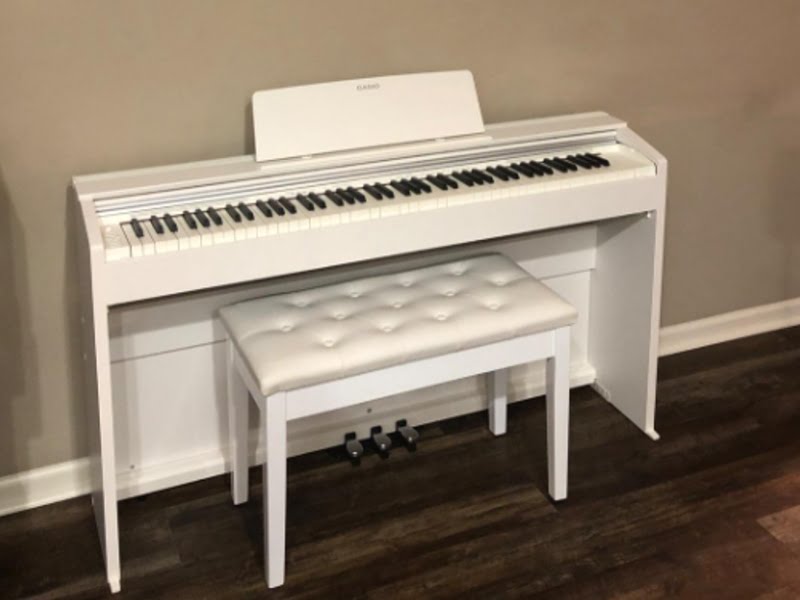
Whenever you look at a digital piano, I highly suggest that the first feature you consider is the piano’s tone. It’s important to get a piano that offers a rich and realistic tone, especially when you’re shopping for a console piano like those in the Casio Privia series.
Between these two pianos, the PX-870 won out. While they share a tone generator, the PX-870 has a better sound library. On top of that, it has a larger cabinet, which produces a much fuller sound that is much closer to the tone of an acoustic piano.
Because of these reasons, the Casio PX-870 ended up winning this comparison.
+Tone Generation
There’s no clear winner between these two pianos if you only look at the tone generator. This is because both of these pianos use the Multi-Dimensional Morphing AiR tone generator. This is one of Casio’s best tone engines so that you can expect rich and realistic sounds from both of these pianos.
One of the highlights of this tone engine is how it handles soft and loud sounds. When playing piano, pianists usually add emotions and dimensions to their sound by playing around with the volume. And with the PX-870 and 850, you can expect a smoother transition before the soft and loud notes, making for a more realistic sound.
And while the sound quality of these two pianos is fairly similar, I couldn’t help but notice a richer tone from the Casio PX-870.
The reason for this is that the piano is larger. This means that the sound waves travel through the wood to produce a much more organic sound. This is a very small difference that most beginners won’t even notice. But if you’re looking for the most detailed and realistic piano tone possible, the Casio PX-870 is the better option.
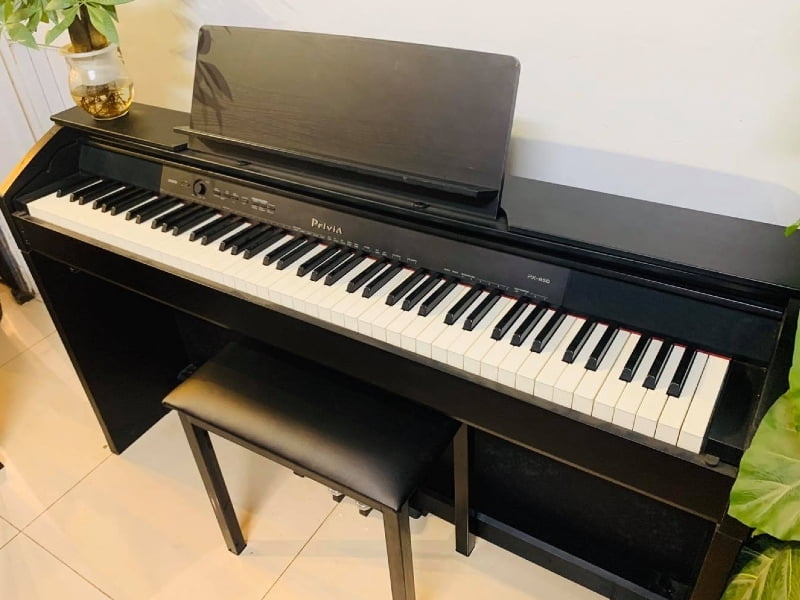
+Sound Library
Another reason the Casio PX-870 won this comparison over the PX-850 is because of its tone library. A key difference between these two pianos is that the Casio PX-870 comes with 19 voices, while the PX-850 only comes with 18.
Most of these voices are the same, but the major difference is that the Casio PX-870 comes with one additional piano voice. This gives you more options when choosing a piano tone to use. On top of that, the additional piano tone is top-quality and great for any piano piece.
So, if you’re looking for quality and variety in your tone, the PX-870 holds a very slight advantage.
Feel
The winner: Tie
If you look at the specs of both pianos, you’ll find that they have the same hammer action. Not only that, but a deeper dive showed me that they even have the same types of keys on the keyboard. So, there was no winner between these two when comparing the piano feel of either option, which is why both pianos came out of this category with a point.
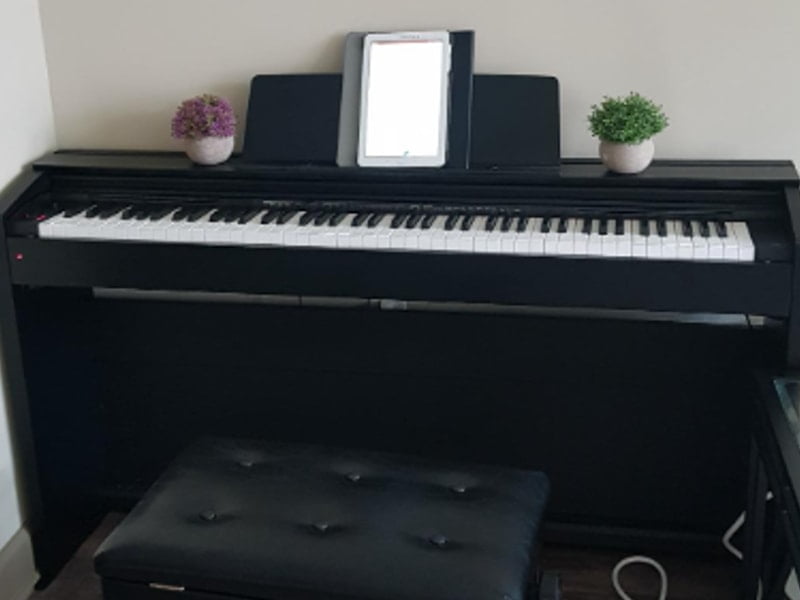
+Hammer Action
One of the primary features of both of these pianos is that they use Tri-Scaled Hammer Action II, one of the newer hammer actions from Casio. This system features a graded weight, which means that the lower keys on the piano will be significantly heavier than the higher keys. This is the same way acoustic piano hammer action works, so it adds a whole new dimension of realism when playing these pianos.
On top of that, this hammer action aims to replicate the slight delay when you hit the keys and when you actually hear the piano sound. This is another very small detail that Casio paid attention to, which is why they are one of the most trusted and popular digital piano brands on the market today.
Most beginners won’t care or even notice the slight delay. However, you definitely feel the difference as these pianos are much more realistic than other digital console pianos in the same price range.
Another great detail that Casio added to these pianos is textured keys. If you play these pianos, you’ll notice that the texture on the white keys is different from the texture on the black keys. This makes the piano feel even closer to an acoustic piano and is another reason these are some of my favorite console digital pianos on the market.
Polyphony
The winner: Tie
The last feature I considered in this comparison was the polyphony. When buying a digital console piano, it’s best to get one with high polyphony to play more notes simultaneously and add more emotion and feeling to your playing.
Luckily, both of these pianos come with 256-note polyphony. This is a huge plus because most digital pianos in this price range have a maximum of 192-note polyphony. So, you get more versatility and flexibility when playing the Casio PX-870 or PX-850, making them great picks for just about any pianist out there.
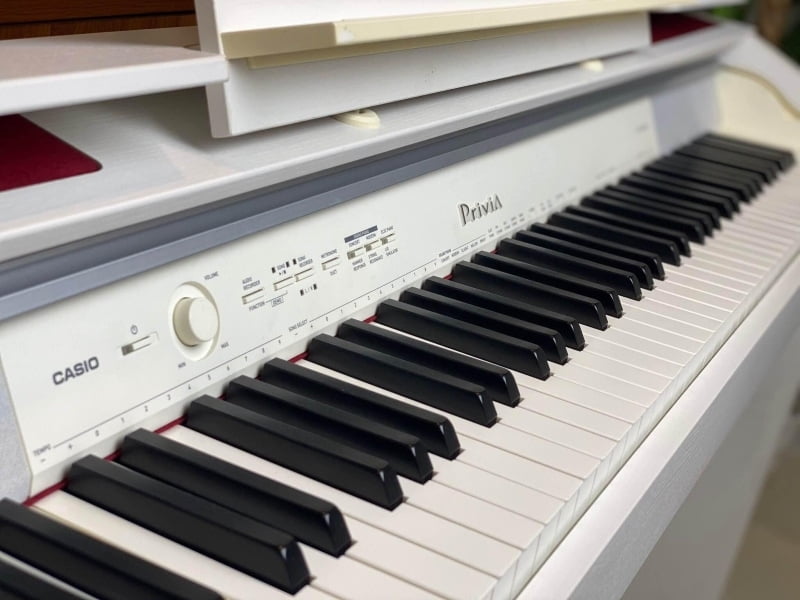
Casio PX-870 vs PX-850: The Similarities
The Casio PX-870 is an upgrade of the PX-850 in the PX product line. The main difference is the fact that the PX-870 has more tones than the PX-850. But aside from that, these pianos are very similar.
In fact, the pianos share the same tone engine, hammer action, and even design. Yes, I know that the Casio PX-870 is slightly bigger. But at first glance, it’s really hard to tell the difference between these pianos, which is something you want to pay attention to.
Additionally both of these pianos come with a range of great playing modes that allow you to explore your musical possibilities. You can layer different voices on top of each other and even split the piano so one side has a different voice than the other.
These are some of the features that made the PX-850 popular upon its release. So, it’s no surprise that Casio kept most of the key features when they released the Casio PX-870.
Quick Rundown of the Casio PX-870
- TRUE PIANO FEEL & EXPRESSION – 88-key Tri-Sensor II Scaled Hammer Action delivers authentic touch with simulated ebony and ivory textures, offering remarkable feel and superior dynamic control.
- IMMERSIVE GRAND PIANO SOUND – The AiR Sound Source delivers rich detail with advanced damper and string resonance, key-off simulation, and mechanical sounds—recreating the full depth of a concert grand.
- POWERFUL 40W SOUND SYSTEM – 4-speaker Sound Projection system fills your space with rich, immersive sound, plus Headphone Mode for quiet practice.
- The Tri-Sensor Scaled Hammer Action II keyboard has an incredible feel and captures the dynamics of a performance with unparalleled speed and accuracy
- BUILT FOR LEARNING – Duet Mode, dual headphone jacks, 60 built-in songs, 2-track MIDI recorder, and Concert Play with orchestral backing tracks.
Last update on 2025-12-13 / Affiliate links / Images from Amazon Product Advertising API
Quick Rundown of the Casio PX-850
- Tri-Sensor Scaled Hammer Action with Ebony and Ivory Keys
- 250 Tones with Split / Layer capability
- 128 note polyphony
- New 4 Layer Stereo Grand Piano Samples
- Stereo Digital Audio Recording to USB storage
Last update on 2025-12-13 / Affiliate links / Images from Amazon Product Advertising API
Related Articles to Casio Px 870
- Casio PX-870 vs AP-470: What Makes the AP-470 Different?
- Casio PX-870 vs Casio AP-650: Which Casio Should You Get?
- Casio PX-870 Vs AP-270: Which Console Digital Piano Should You Get?
- Casio PX-870 Vs Yamaha YDP-163: Which Digital Piano Is The Better Option?
- Casio PX-870 Vs Yamaha YDP-143: A Look At Two Top Digital Console Pianos
- Casio PX-870 Vs Yamaha P-125: Should You Get A Portable Or Console Digital Piano?
- Casio PX-870 Vs Kawai KDP-110: The Best Digital Pianos In The Price Range?
- Casio PX-870 Vs Roland F140R: Which Is The Better Piano?
- Casio PX-870 Vs Roland FP-30: Which Piano Should You Choose?
- Casio PX-870 Vs 860: A Battle Of Two Privia Pianos
- Casio PX-870 Vs Roland RP102: Which Is The Better Console Digital Piano For Beginners?
- Casio PX-870 Vs PX-780: Which Casio Model Is Best For You?
- Casio PX-870 Vs Yamaha YDP-164: Which Is The Better Choice For Beginners?
- Casio PX-870 Vs Yamaha YDP-144: Which Is The Better Console Digital Piano?
- Casio PX-770 Vs 870: Which Casio Console Digital Piano Is Better?
References:
- Casio PX-870: https://www.casio-intl.com/asia/en/emi/products/px870/spec/
- Casio PX-850: http://arch.casio-intl.com/asia-mea/en/emi/privia/px850/spec/
Lulacruza is an electronic folk duo operating at the junction of the hypermodern and the ancient. Our music weaves together hypnotic female singing, South American folk instruments and electronic processing, while channeling pulsating waves from the source of creation.
Lalucruza is also a community where you can connect with other music lovers to collaborate, exchange ideas and share knowledge. A platform for who wants to learns the basics of playing piano, guitar, drum masters’ technique, etc.. is the premise of our website.
